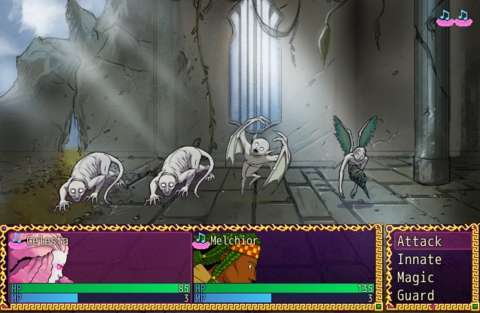If you chip away at Remnants of Isolation’s outer shell–its piano-heavy soundtrack, turn-based combat, and vibrant color palette–you’re left with a lifeless love story. This dyadic core leaks into each subsequent layer, from the party system that never expands beyond a twosome to the title screen overpowered by two tightly clutched hands superimposed over a gang of silhouetted fiends unmoved by the romance. The narrative drives the experience, but the ride is neither touching nor inspiring. The bond between hero and heroine is hampered by the female character’s lack of a voice, and the inconsistent writing makes it difficult to care when the male lead fumbles his way through conversations. The surrounding elements have their charm, but Remnants of Isolation falls far short of making a believable or memorable emotional connection.
The stage is set with a scene of isolation. Stowed away in a castle is a lilac-skinned girl with eyes of mismatched colors, absent a voice but masterful with an acoustic instrument that she can summon from thin air. She’s alone and seems to have been that way for some time, but that changes once she’s mysteriously freed from her prison and runs into a brash, out-of-sorts mage, quick to make friends. Unfortunately, the girl cannot speak to the nature of the castle (or speak at all, for that matter), so the couple must explore its many corridors to discover their purpose for being there and, more importantly, how to escape.
 The game plays out in a window–and a tiny one at that.
The game plays out in a window–and a tiny one at that.
Learning both characters’ connections to the castle can be interesting, but Remnants of Isolation runs just shy of three hours. That gives these two strangers a remarkably short window to get to know each other, let alone foster any sort of tender relationship. Additionally–and I’ll continue to press this issue–the female lead is mute. Maybe it’s her prolonged confinement that’s kept her silent, but robbing such a substantial character of opinions, personality, and any opportunity to connect with the player at a deeper level is a missed opportunity. The text boxes are dominated by the hero, Melchior, who alternates between exposition-heavy blurbs and uncomfortable romantic gestures that he often retracts in embarrassment. The scattered notes that provide context for your environment tend to be well-written and mostly interesting, but the dialogue leads to more eyes rolled than hearts warmed.
The link that the duo shares during battle is much more substantive. Along with a standard physical attack, each character can launch either an “innate” ability or a spell. Using your fire, ice, or lightning magic on its own doles out significant damage, but leading with one character’s innate ability and following with the other’s spell produces a combination attack that might do double damage, hit multiple targets, or cause myriad status effects. As you gain levels and acquire new abilities, your arsenal of offensive and defensive maneuvers expands, and you often need to experiment mid-battle to come up with combos that hit the hardest.
For a two-character, turn-based system, there’s plenty of strategy here. Both players start each battle with just three MP–gaining two additional points per turn–so it’s critical to balance your attacks and not lean too heavily on a single spell or character, lest you run your MP dry. The enemies you run into don’t go down easy, either, and the creatures you encounter don’t often respawn after being defeated. Grinding out levels and currency isn’t a viable option, so Remnants of Isolation trusts you to fight the fights presented and choose well-timed techniques over brute force.
 Made from Forgiveness Wax, presumably.
Made from Forgiveness Wax, presumably.
Creating new gear and optimizing your characters is rewarding, but the game’s linearity and brief runtime don’t allow for much variability in how you outfit your party. You earn souls from each battle, and this currency is used to create weapons, armor, and items. If there were a deeper weapons cache–multiple status effects tied to specific items or armor that heavily favored magic defense over physical defense–this system might be more interesting. There’s an optimal permutation for each character, and as long as you engage in most battles and smartly spend your souls, you’ll easily maximize your gear before the final encounter.
The most emotionally resonant aspect of Remnants of Isolation might just be its sound design. The sweet, soft soundtrack is expertly accented by the satisfying pings and hums associated with even the most ordinary actions. Opening chests and surfing through menus just sounds good, but the visual counterpart does little to complement the sound. Remnants of Isolation was crafted in RPG Maker, so its familiar assets and a run-of-the-mill fantasy aesthetic make for an uneven visual package, and being forced to play in windowed mode doesn’t exactly benefit the experience, either.
It just doesn’t strike as many chords or hit as many notes as it should. Remnants of Isolation is a truncated RPG that never allows its story or progression system to properly develop, and while the focus on a pair instead of a full party pays off in combat, the woefully undercooked bond between the protagonists never does enough to make you care about any of the three possible endings. It can be sweet, but Remnants of Isolation has far too many potholes to be worth its notably short ride.
Powered by WPeMatico


